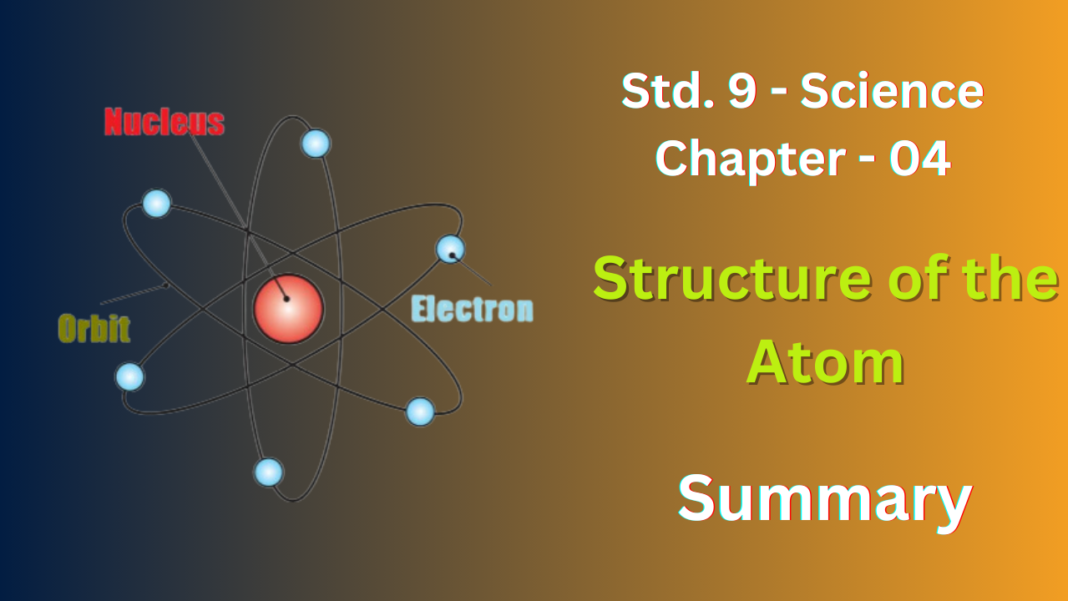NCERT Solutions for Class 9 Science Chapter 4
The chapter Structure of the Atom on the structure of the atom in your class dives into the building blocks that make up everything around you! Here’s a quick summary:
The Atom’s Building Blocks:
- Electrons: Tiny, negatively charged particles that zip around the outside of the atom.
- Protons: Positively charged particles that clump together in the atom’s center, forming the nucleus.
- Neutrons: No electrical charge, found in the nucleus with the protons.
The Atomic Model:
Scientists have developed models to depict the atom’s structure. The chapter likely covers two important ones:
- Thomson’s Model: Imagined the atom as a positively charged ball with electrons scattered throughout.
- Rutherford’s Model: Proposed a tiny, dense positively charged nucleus at the center with electrons whizzing around it like planets around the sun.
Key Points to Remember:
- The number of protons in an atom defines its identity (element).
- The number of protons and neutrons together determine the atom’s mass.
- Electrons fill specific energy levels around the nucleus.
This is just a basic overview. The chapter likely goes into more detail about these concepts and may introduce isotopes and other interesting atomic structures.
NCERT Solutions for Class 9 Science Chapter 4
Q1.Compare the properties of electrons, protons and neutrons.
Ans: Here’s a comparison of electrons, protons, and neutrons:
| Property | Electron | Proton | Neutron | |
| Charge | Negative (-) | Positive (+) | Neutral (no charge) | |
| Location in Atom | Outside the nucleus, in energy levels | Inside the nucleus | Inside the nucleus | |
| Mass | Very small (almost negligible compared to protons and neutrons) | Approximately 1 atomic mass unit (amu) | Approximately 1 amu (slightly heavier than a proton) | |
| Stability | Stable in atoms with complete electron shells | Stable | Relatively stable within the nucleus, but can decay outside it | |
| Importance to Atom | Determines chemical properties | Defines element identity (atomic number) | Contributes to atomic mass |
Q2. What are the limitations of J.J. Thomson’s model of the atom?
Ans: Thomson’s atom model couldn’t explain how atoms are stable or the results of experiments showing a tiny, dense positive core.
Q3.What are the limitations of Rutherford’s model of the atom?
Ans: Rutherford’s model, while a leap forward, had two main limitations:
- Unstable Atoms: According to physics, a charged particle moving in a circle (electrons in Rutherford’s model) loses energy and spirals inward. This predicted atoms wouldn’t be stable, which isn’t true.
- Electron Arrangement: The model didn’t explain how or why electrons occupy specific locations (energy levels) around the nucleus.
Q4. Describe Bohr’s model of the atom.
Ans: Bohr’s model fixed Rutherford’s by placing electrons in specific energy levels, like rungs on a ladder, instead of freely orbiting. Electrons jump levels by absorbing or releasing energy as light.
Q5. Compare all the proposed Bohr’s models of an atom given in this chapter.
Ans: There is only one Bohr’s model of the atom described in this chapter.
In Bohr’s model:
- Electrons reside in fixed energy levels (orbits) around the nucleus.
- Each orbit has a specific energy level, with farther orbits having higher energies.
- Electrons are stable in their designated levels and don’t radiate energy.
- Electrons can jump between orbits by absorbing or releasing energy as light particles (photons).░
Q6. Summarise the rules for writing of distribution of electrons in various shells for the first eighteen elements.
Ans: Here are the rules for writing the electron distribution of the first eighteen elements:
- Maximum Capacity: Each shell (energy level) has a maximum number of electrons it can hold. This is given by the formula 2n^2, where n is the shell number (1 for the innermost shell, 2 for the next, and so on).
- Aufbau Principle: Electrons fill shells in a step-wise manner, starting from the lowest energy level (innermost shell) and moving outwards. Inner shells must be filled before adding electrons to outer shells.
- Octet Rule: The outermost shell (valence shell) tends to have a maximum of 8 electrons. This is especially stable and influences an element’s chemical behavior.
Following these rules, you can write the electron distribution for the first eighteen elements using symbols like He: 1s^2 (Helium with 2 electrons in the first shell) or Ne: 2s^2 2p^6 (Neon with 2 electrons in the second shell and 6 in the second sub-shell).
Q7. Define valency by taking examples of silicon and oxygen.
Ans: Valency is how many bonds an atom forms. Look at outer electrons (valence electrons). Silicon (4 outer electrons) has a valency of 4, oxygen (needs 2 to fill outer shell) has a valency of 2.
Q8 .Explain with examples: (i) Atomic number (ii) Mass number, (iii) Isotopes and (iv) Isobars.
Ans: Atomic number: Unique ID for elements, equal to the number of protons (positive charge). (Ex: Carbon = 6 protons)
Mass number: Total weight of the atom, sum of protons and neutrons. (Ex: Carbon-12 = 6 protons + 6 neutrons)
Isotopes: Same element (same protons) with different neutron numbers (different mass). (Ex: Carbon-12 and Carbon-14)
Isobars: Different elements (different protons) with the same mass number. (Ex: Potassium-40 and Argon-40)
Q9. Na+ has completely filled K and L shells. Explain.
Ans: You’re absolutely right! Here’s why:
- Sodium (Na): A normal sodium atom has 11 electrons.
- Electronic Configuration: These electrons are arranged in shells. Sodium’s configuration is typically written as 1s²2s²2p⁶ (2 electrons in the first shell, 2 in the second, and 6 in the third).
- Losing an Electron: When sodium becomes a sodium ion (Na⁺), it loses one electron. This electron is most likely lost from the outermost shell (the 3rd shell with 6 electrons).
- Filling the Shells: Now with 10 electrons, the remaining electrons comfortably fill the first two shells (K and L shells). The K shell holds a maximum of 2 electrons, and the L shell holds a maximum of 8 electrons. Since Na⁺ has 2 electrons in the first shell and 8 in the second, both K and L shells are completely filled.
So, Na⁺ losing an electron from its outermost shell results in a stable configuration where the K and L shells are completely filled.
Q10. If a bromine atom is available in the form of, say, two isotopes 7935 Br (49.7%) and 8135Br (50.3%), calculate the average atomic mass of the bromine atom.
Ans: Weighted average atomic mass = (⁷⁹Br mass × ⁷⁹Br abundance) + (⁸¹Br mass × ⁸¹Br abundance)
= (78.9183 amu × 49.7%) + (80.9163 amu × 50.3%)
= 79.923294 amu
Therefore, the average atomic mass of bromine is approximately 79.92 amu.
Q11. The average atomic mass of a sample of an element X is 16.2 u. What are the percentages of isotopes 168X and 188X in the sample?
Ans: We can rewrite the equation considering this:
(x * 168 amu) + ((100 – x) * (168 amu + 22 amu)) = 16.2 u
Simplifying the equation:
168x + 190(100 – x) = 1620
Expanding and rearranging:
-22x + 19000 = 1620
-22x = -17380
x = 790/11 (approximately 71.82%)
Therefore:
- Percentage of ¹⁶⁸X (x) = 71.82% (approximately)
- Percentage of ¹⁸⁸X (100 – x) = 28.18% (approximately)
Q12. If Z = 3, what would be the valency of the element? Also, name the element.
Ans: If Z = 3, then the element is Lithium (Li).
The atomic number (Z) corresponds to the number of protons in the nucleus. In Lithium, there are 3 protons.
The valency of Lithium is 1.
Q13. Composition of the nuclei of two atomic species X and Y are given as under X – Y Protons =6 6 Neutrons = 6 8 Give the mass number of X and Y. What is the relation between the two species?
Ans: The mass number of an atom is the sum of protons and neutrons in the nucleus.
- Mass number of X: Protons (6) + Neutrons (6) = 12
- Mass number of Y: Protons (6) + Neutrons (8) = 14
Since both X and Y have the same number of protons (6) but different numbers of neutrons, they are isotopes of the same element. Isotopes have the same chemical properties but differ slightly in physical properties due to the varying mass.
Q14. For the following statements, write T for True and F for False.
(a) J.J. Thomson proposed that the nucleus of an atom contains only nucleons.
(b) A neutron is formed by an electron and a proton combining together. Therefore,it is neutral.
(c) The mass of an electron is about 1/2000 times that of proton.
(d) An isotope of iodine is used for making tincture iodine, which is used as a medicine.
Ans; (a) false
(b) true
(c) true
(d) true
Q15. Rutherford’s alpha-particle scattering experiment was responsible for the discovery of (a) Atomic nucleus (c) Proton (b)Electron (d)neutron
Ans: (a) atom nucleus
Q16. Isotopes of an element have (a) the same physical properties (c) different number of neutrons (b)different number of neutrons (d) different atomic numbers.
Ans; (c) different number of neutrons.
Q17. Number of valence electrons in Ct ion are : (a) 16 (b) 8 (c) 17 (d) 18
Ans: (b) 8
Q18. Which one of the following is a correct electronic configuration of sodium? (a) 2, 8 (b) 8, 2, 1 (c) 2, 1, 8 (d) 2, 8, 1
Ans: (d) 2, 8, 1
NCERT Solutions for Class 9 Science Chapter 4
FAQ’s
What topics are covered in Class 9 Science Chapter 4: “Structure of the Atom”?
Class 9 Science Chapter 4 explores the fundamental concepts of atomic structure, covering topics such as the discovery of subatomic particles, Bohr’s atomic model, and the arrangement of electrons in atoms.
How can NCERT solutions for Class 9 Science Chapter 4 help in understanding the structure of the atom?
NCERT solutions offer detailed explanations and analyses of concepts related to the structure of the atom, helping students understand the arrangement of subatomic particles, atomic models, and the behavior of electrons in atoms.
Where can I find NCERT solutions for Class 9 Science Chapter 4?
NCERT solutions for Class 9 Science Chapter 4 can be found online or in study materials provided by educational platforms or institutes specializing in academic resources.
When should I refer to NCERT solutions for Class 9 Science Chapter 4?
NCERT solutions are beneficial for reinforcing learning, clarifying doubts, and preparing for exams. They can be used alongside regular study or as a revision tool before assessments to enhance understanding of the structure of the atom.
What specific examples are discussed in Class 9 Science Chapter 4 regarding the structure of the atom?
Class 9 Science Chapter 4 discusses various examples of atomic structure, such as the Rutherford model, the Bohr model, and the modern quantum mechanical model, offering insights into the evolution of our understanding of the atom’s structure.









